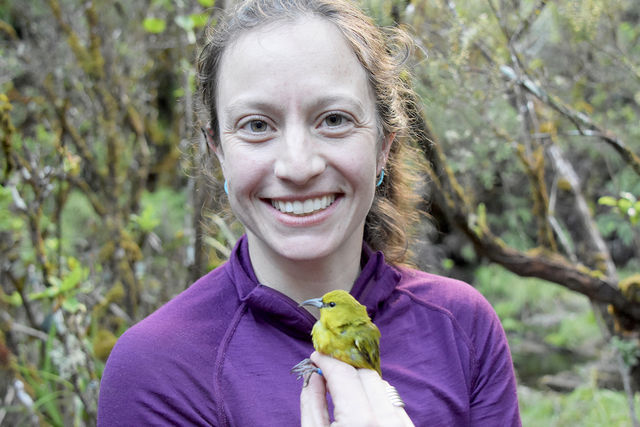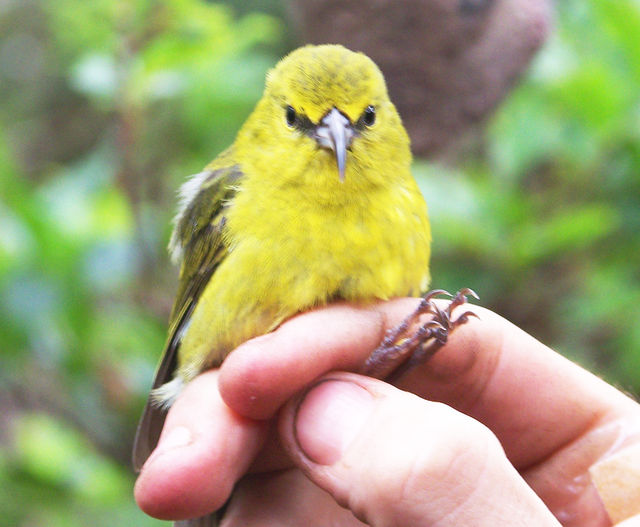KOKEE — Avian malaria is a threat to many of Kauai’s native and endangered birds, and an ongoing study of the way they adapt to disease could lead to ways to rehabilitate some species. “What we’re trying to do is
KOKEE — Avian malaria is a threat to many of Kauai’s native and endangered birds, and an ongoing study of the way they adapt to disease could lead to ways to rehabilitate some species.
“What we’re trying to do is understand how disease affects these forest birds,” said Eben Paxton, avian ecologist with USGS Pacific Island Ecosystems Research Center. “Avian malaria and avian pox have really devastated the Hawaii native forest birds and has limited many species to high elevations.”
Avian pox and avian malaria are vector-transmitted diseases, meaning they’re passed through bird populations by mosquitoes. Native birds, like the amakihi, have little immunity to the non-native diseases carried by these non-native insects.
Loren Sackett, research affiliate with the Smithsonian Institution, brought Paxton on board with her general research centered on the evolution of diseases in wildlife. She’s also partnered with the Kauai Forest Bird Recovery Project for collecting blood samples in the field.
“My research program in general is centered on the evolution of diseases in wildlife,” Sackett said. “I have a couple of systems where there’s this introduced disease and in some time the native species evolved resistance.”
The center of the project is the amakihi, a species of the Hawaiian honeycreeper. The goal is to determine the genetic resistance in amakihi toward avian malaria.
Amakihi on the Big Island seem to be developing genetic resistance, or tolerance, to avian malaria, Sackett said. So she’s investigating amakihi populations across the islands for comparison.
Kauai’s amakihi came into play as an attempt to understand how consistent the response to malaria was among different species.
“We’re gathering data from all the islands to try and figure out the basis of genetic resistance in amakihi,” Sackett said. “It was apparent to me that Kauai amakihi are not reacting to malaria in the same way as they are on other islands.”
KFBRP has been helping capture the amakihi — and now is the time to catch them, said Lisa “Cali” Crampton of KFBRP.
The capture process, which involves using nets and calls to lure in the birds, has been moving slowly.
“We haven’t had any success luring them into the nets except for one that we caught in the fall,” Crampton said. “They hang out in the canopy and they fly high. There’s not that many left, and we’re in an area where they are kind of rare.”
KFBRP is set up at the edge of the Kauai amakihi range to get samples for Sackett from across the birds’ range.
Initially, amakihi that live at lower elevations seem to be more resistant or tolerant to avian malaria than those at higher elevations.
The theory is that the birds’ genes have changed over time to adapt to the disease in areas where mosquitoes are more abundant. Researchers want to identify these genes.
“If we can identify these genes, there’s a lot of conservation actions we can take to try to help these birds persist,” Paxton said.
One of those actions is to identify birds that have the genetic resistance to avian disease and translocate those birds into populations with a higher susceptibility.
“So the genes get spread out to the more susceptible populations,” Paxton said.
Other conservation efforts could include introducing antibodies to the birds that could be passed on to their young.
“There’s a number of ways we could help these birds get to a point where they can live with malaria,” Paxton said.
KFBRP could use help with its part of the project, Crampton said.
“Because we’re in Kokee, it’s a nice opportunity to involve volunteers and do outreach and training,” Crampton said.
Info: Kauai Forest Bird Recovery Project, (808) 335-5078.



